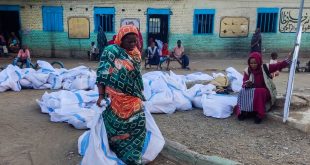STOCKHOLM, Sweden, Aug 16 (IPS) – During the first half of the 20th century, antisemitism was endemic in Europe and eventually burst out in full force when Nazi-Germany and its collaborators between 1941 and 1945 systematically (and well-documented) murdered six million Jews across German-occupied Europe.
In an environment mined by hostile public opinion, the Zionist Nahum Sokolow popularized the Hebrew term Hasbara. The word has no real equivalent in English, but might be translated as “explaining”, indicating a strategy seeking to explain actions, regardless whether or not they are justified.
As a skilled diplomat, Sokolow based his widely publicized opinions on in-depth research of actual events, though he presented his findings in a manner that favoured his cause.

The State of Israel has often used hasbara, now generally described as public diplomacy, meaning that policies and actions have not been denied, but at the same time has any criticism of such facts been presented as biased and/or tinged by “antisemitism”.
To avoid being labelled as antisemitic the following article is mainly based on two books by Ilan Pappé – The Biggest Prison on Earth: A History of the Occupied Territories and The Ethnic Cleansing of Palestine.
Pappé is considered to be a member of the New historians, a loosely defined group of Israeli historians who challenge the official version of Israel’s role in the 1948 expulsion of Palestinians. An event which among Palestinians is called Nakba, the Catastrophe.
In 1948, more than 700,000 Palestinian Arabs, about half of the former British controlled Mandatory Palestine’s predominantly Arab population, fled from their homes.
At first they were attacked by Zionist paramilitaries and after the establishment of the State of Israel by its regular army, acting on direct orders from the newly founded nation’s leaders.
Dozens of massacres targeted the Arab population and between 400 and 600 Palestinian villages were destroyed. Village wells were poisoned and properties looted to prevent Palestinian refugees from returning.
The New historians debunked several myths. For example, that the British Government tried to prevent the establishment of a Jewish state – it was actually against the founding of a Palestine state.
The official version states that Palestinians fled their homes on their own free will, instigated to do so by surrounding Arab states. However, the majority of them were actually expelled, and/or fled out of a well-founded fear of the Israeli army.
Furthermore, general opinion has been that the surrounding Arab nations at the time were united and more powerful than the newly established State of Israel – as a matter of fact, Israel had the advantage both in manpower and arms, while the Arab nations were divided by internal strife and did not have a coordinated plan to destroy Israel.
The recurrent praise that the Israelis made the desert bloom and took over a land without a people for a people without a land, are according to Pappé unfounded clichés. Before the ethnic cleansing the vast majority of agricultural land was being cultivated by Palestinians. It is estimated that on the eve of the 1948 war, around 739,750 acres of agriculturally apt land were being cultivated by Palestinians, actually greater than the physical area which was under cultivation in Israel almost thirty years later.
The appropriation of Palestinian land occurred in conjunction with a Land Acquisitions Law allowing for a mass transfer of the entire Palestinian economy to the Israeli state. Practically overnight, the State gained control of a vast amount of fertile land, 73,000 houses, and 7,800 workshops. This dropped the average cost of settling a Jewish family in Palestine from 8,000 USD to 1,500 USD.
Furthermore, the whole issue whether Palestine belongs to “Jews” or “Arabs” is somewhat spurious. It is a myth that any region constitutes a closed environment. Trade, immigration, invasion and intermarriage are part of any nation’s history.
Across the millennia, additions and losses have befallen people living in Palestina (it was the Romans who in 131 CE changed the denomination “Judea” into “Syria Palaestina”). Conquerors, like those of the Muslim faith, seldom replaced an entire native population, they only added to it.
Many of the Palestinians of today are the Jews of yesteryears. Palestinian Arabs did not suddenly appear from the Arabian Peninsula in the 7th century to settle in Palestine, most of those “Arabs” living there now are descendants of indigenous peoples who lived there before. People who, like most others, over time have changed their beliefs and traditions. For example, Sardinians eventually became Italians, but no one would suggest that Sardinians were kicked out and replaced by a foreign Italian people.
We ought to separate political nationalist identities from the actual reality of a human being. Nationalism is a relatively modern concept, especially in the Middle East.
Likewise, the Jewish diaspora was not the result of a sudden expulsion of Jews from their Holy land. It was, just as current migration, a result of various factors, including refugees from war and repression, forced labour, deportation, overpopulation, indebtedness, military recruitment, and not the least opportunities in business, commerce, and agriculture.
Before the Romans in 70 CE destroyed Jerusalem and its temple and in 131 forbade Jews to settle there, large and prosperous Jewish communities existed in provinces like Egypt, Crete, Cyrenaica, Syria, Asia, Mesopotamia, and in Rome itself.
However, the destruction of the temple of Jerusalem motivated many Jews to formulate a new self-definition and adjust their existence to the prospect of an indefinite period of displacement, that eventually would culminate in a return to a mostly imaginary realm of Israel. In 1948, this religious dream became a reality through the establishment of the Jewish State of Israel.
A development that by most the U.S. and European politicians was considered to strengthen a “Western” strategic, economic, and political presence in the Middle East, at the same time as the establishment of Israel could ease the burden of a bad conscience for not having done enough to hinder the extermination of Jews, combined with easing the pressure to resettle and compensate the victims.
Nowadays, the Sate of Israel does not only control the land granted to it by the British, but also territories inhabited by also areas like the West Bank, the Golan Heights and the Gaza strip. In Gaza, Israel maintains control of its airspace, its territorial waters, no-go zones within the strip, and the population registry. Pappé has stated that
“the tale of Palestine from the beginning until today is a simple story of colonialism and dispossession, yet the world treats it as a multifaceted and complex story – hard to understand and even harder to solve. Indeed, the story of Palestine has been told before: European settlers coming to a foreign land, settling there, and either committing genocide against or expelling the indigenous people. The Zionists have not invented anything new in this respect. But Israel succeeded nonetheless, with the help of its allies everywhere, in building a multilayered explanation that is so complex that only Israel can understand it. Any interference from the outside world is immediately castigated as naïve at best or anti-Semitic at worst.”
On October 11th 2023, Hamas-led fighters breached the Gaza-Israel barrier, attacking military bases and massacring civilians in 21 communities, killing 1,139 people, including 695 Israeli civilians, among them 38 children, 71 foreign nationals, and 373 members of the Israeli security forces, while taking about 250 Israelis as hostages. Incidents of great brutality and rape were witnessed and reported.
Israeli repercussion was swift and merciless. Israel has ravaged the Gaza Strip. Apartment buildings, mosques, schools, hospitals, and universities have been reduced to rubble.
During their hunt for Hamas fighters Israel has deliberately targeted and destroyed civilian structures where civilians have sought refuge. On May 21st 2024, Israeli government offered its first estimate of the operation’s death toll, claiming its troops had killed 14,000 terrorists and 16,000 civilians. A week earlier the U.N. reported that approximately 35,000 individuals had died during the conflict, including 7,797 minors, 4,959 women and 1,924 elderly, the latter three groups with confirmed identities. Among the victims were 103 journalists and 196 humanitarian workers.
At almost the same time, Save the Children reported that more than 13,000 children had been killed, while WHO stated that at least 1,000 children have had one or both legs amputated. On the 11th of August the death toll was estimated to be approximately 39,000 people.
The killing is continuing unabated, worsened by starvation. WFP recently reported that 1.1 million Gaza inhabitants are facing catastrophic hunger.
In northern Gaza, one in three children under two years of age suffer from acute malnutrition. According to estimates by UNICEF, people’s daily nutritional intake is down to 245 calories, i.e. less than a can of beans. This is mostly attributable to an Israeli blockade that according to UNICEF since March 1 has stopped 30 percent of aid missions, letting in a daily average of only 159 of the required 500 aid trucks.
Even before October 11th people of Gaza had an intolerable existence, lacking sufficient access to electricity, potable water, food, and medical equipment. Unemployment rate was more than forty per cent, while children grew up in a world of intermittent war and persistent trauma, of barbed wire and surveillance. Israeli attacks continue while remains of Hamas’ military branch has become a drastically diminished insurgent force, which fighters pop up from the rubble to shoot at Israeli soldiers.
An entire population has been severely punished for the presence of a fanatical, political party, which according to polls conducted in September 2023 by the majority of Gazans was considered to be repressive and corrupt, but which they were frightened to criticize. Hamas’s support was estimated to be between 27 and 31 percent, though since many Gazans are unable to perceive a viable solution to Israel’s iron grip on their confined strip of land, they consider armed resistance to be the only way out.
In Israel, Benjamin Netanyahu’s two decades long regime has tried to sabotage a two-state-solution by weakening the Palestinian Authority on the West Bank, allowing for vast amounts of mainly Qatari money to reach Hamas, in exchange for maintaining a ceasefire and sowing division within Al-Fatah, the party governing the West Bank.
Part of this policy has also been the increased support to 144 Israeli settlements within the West Bank, including 12 in East Jerusalem, and a discreet sustenance to over 100 “Israeli outposts”, i.e. settlements not authorized by the Israeli government. Over 450,000 Israeli settlers reside in the West Bank, with an additional 220,000 in East Jerusalem. Living in a settlement is made attractive through lower costs of housing compared to living in Israel proper. Government spending per citizen in settlements is double, in some cases triple, than what is spent per Israeli citizen in Israel proper.
The International Court of Justice (ICJ) has ruled that Israeli settlements on occupied territory is, according to international laws, illegal and established that Israel has “an obligation to cease immediately all new settlement activities and to evacuate all settlers from the occupied territories”. The Court is talking to deaf ears.
A current expansion of settlements has involved the confiscation of Palestinian land and resources, leading to displacement of Palestinian communities while creating a source of tension and conflict. The UN Office for Coordination of Humanitarian Affairs (OCHA) reported that from 1 January to 19 September 2023, Israeli settlers killed 189 Palestinians in the occupied West Bank and wounded 8,192. The violence increased after October 3rd, after that date 460 Palestinians have so far been murdered by settlers. On average, there are every day three cases of settlers attacking Palestinians in the West Bank, resulting in the killing and injuring of Palestinians, harming their property, and preventing them from reaching their land, workplace, family, and friends.
International ramifications are continuously unfolding – armed exchanges between Israel and Iran, between Israel and Hezbollah, Iran supported Houthi attacks on commercial shipping in the Red Sea, followed by Israeli counterattacks on Yemen, waves of pro-Palestine demonstrations across Europe, the U.S., and Arab capitals, combined with increased antisemitism. All this could for Israel mean its worst defeat ever, while at the same time it may for Palestinians prove to be more deadly and devastating than the Nakba.
IPS UN Bureau
Follow @IPSNewsUNBureau
Follow IPS News UN Bureau on Instagram
© Inter Press Service (2024) — All Rights ReservedOriginal source: Inter Press Service
 Top Naija News – Nigeria News, Nigerian News & Top Stories Top Naija News – Nigerian Newspapers, Nigerian News. topnaijanews is a daily Nigerian newspaper covering Latest News, Breaking News, Entertainment, Sports, Lifestyle and Politics.
Top Naija News – Nigeria News, Nigerian News & Top Stories Top Naija News – Nigerian Newspapers, Nigerian News. topnaijanews is a daily Nigerian newspaper covering Latest News, Breaking News, Entertainment, Sports, Lifestyle and Politics.




